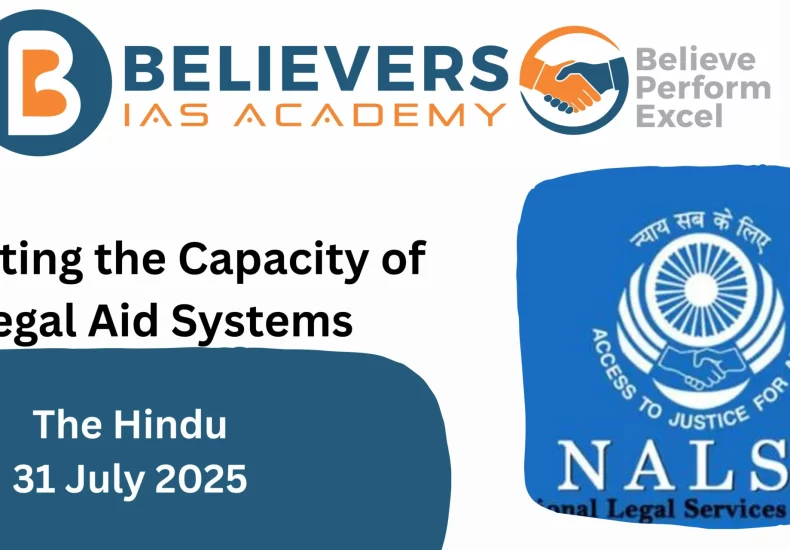Boosting the Capability of Authorized Help Techniques
Background
The Authorized Companies Authorities Act, 1987 supplies the statutory framework at no cost authorized assist in India, in keeping with Article 39A (DPSP) and as a part of the Proper to Life beneath Article 21. Its mandate is bold — to serve almost 80% of the Indian inhabitants who qualify based mostly on financial and social vulnerability.
Present Standing of Authorized Help in India
-
Beneficiary Attain: In 2023–24, authorized assist reached 15.5 lakh folks, an enchancment of 28% from the earlier 12 months, but a fraction of its supposed goal.
-
Institutional Presence: Entrance workplaces are positioned in courts, prisons, and juvenile boards, offering free counsel by empanelled legal professionals.
-
Rural Outreach: Authorized assist clinics exist at a ratio of 1 for each 163 villages (India Justice Report, 2025), leaving vital rural gaps.
Funding Constraints
-
Price range Allocation: Authorized assist receives lower than 1% of the full justice finances (police, judiciary, prisons, authorized assist mixed).
-
Funding Developments:
-
States: Allocation grew from ₹394 crore (2017–18) to ₹866 crore (2022–23).
-
NALSA: Funding decreased from ₹207 crore to ₹169 crore, and utilisation dropped from 75% to 59% in the identical interval.
-
-
NALSA Handbook 2023: Imposes restrictions on fund utilization (e.g., hiring, sufferer compensation, meals distribution), and units spending norms: 50% for authorized assist, 25% for consciousness, 25% for ADR/mediation.
Shrinking Frontline Workforce
-
Para-Authorized Volunteers (PLVs): Key intermediaries for consciousness era and dispute decision. Their power dropped 38% — from 5.7/lakh inhabitants (2019) to 3.1/lakh (2023).
-
State Disparities: West Bengal and Uttar Pradesh have only one PLV per lakh inhabitants, severely limiting grassroots attain.
Authorized Help Defence Counsel (LADC) Scheme
-
Launched in 2022, modelled on the public defender system, centered on offering authorized assist to accused individuals (not victims).
-
Operational in 610 of 670 districts.
-
Price range: Absolutely utilised ₹200 crore (2023–24), however allocation lowered to ₹147.9 crore in 2024–25.
-
Goal: Enhance high quality of authorized defence and scale back the load on common authorized assist panels.
Challenges
-
Poor service high quality and insufficient accountability.
-
Public mistrust of free authorized assist providers.
-
Overburdened and undertrained legal professionals, particularly in rural areas.
-
Restrictive spending norms that hamper innovation and responsiveness.
Method Ahead
-
Improve Funding & Utilisation:
-
Enhance NALSA and State allocations with versatile utilisation norms.
-
Ringfence budgets for PLV recruitment, capacity-building, and LADC strengthening.
-
-
Develop Human Assets:
-
Strengthen Institutional Accountability:
-
Group-Centric Outreach:
-
Reform Authorized Help Supply:
Conclusion
India’s authorized assist system, although rooted in constitutional ensures of equal justice, stays underfunded, understaffed, and underutilised. Bridging these gaps requires elevated funding, professionalisation, and community-driven reforms. Strengthening authorized assist will not be solely a DPSP obligation beneath Article 39A but in addition a prerequisite for making Article 21’s promise of truthful and equal entry to justice a lived actuality, significantly for essentially the most weak sections of society.


Leave a Reply